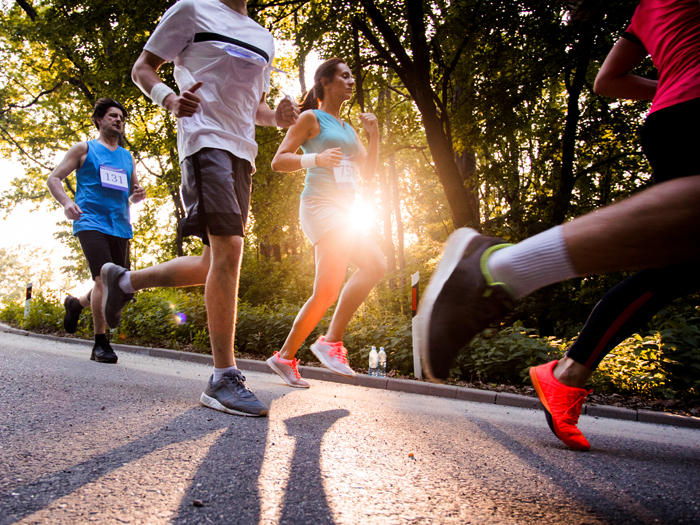7 Tips for Walking Your First 5K Race
Signing up for a 5K is a great way to level up your walking routine. Use these expert tips to enjoy your way to the finish line.

If there's a 5K run happening in your area and you love to walk, you may be inclined to sign up. But whether you have a welcoming experience or feel left behind in the runners' dust depends on which event you pick.
Many 5Ks touted as fundraisers, fun runs, or community events are open to walkers. Others, often sponsored by running clubs and advertised as races, are geared toward serious runners-and their organizers aren't interested in waiting around for every last walker to cross the finish line.
"There's a difference between a charity run and a race," says Michael Ring, a past vice president of the Prospect Park Track Club in Brooklyn, New York. He's also a former marathon runner turned walker. "At a race, we keep the finish line open at a 15-minute-per-mile pace. Anything slower than that isn't running, and we're running races."
If you aren’t sure whether an upcoming event is right for walkers, read through the brochure or check out the website.
"Community events are often walker-friendly, because the more people who register, the more successful the race is," says Kevin Pennington, manager of the Northwestern Medicine Athletic Training and Sports Performance Clinic in Warrenville, Illinois. "If the brochure doesn't seem to suggest walkers are welcome, either call to ask or move on to investigating another event."
Once you find a winner, there's still more to consider for a successful race day. We asked walking experts and people who have experience walking 5Ks-including former runners-what they wish someone had told them before showing up at the starting line. Here's their best advice.
Stay active, have fun, get fit—with SilverSneakers! Classes and events are happening right now at participating gyms, online through SilverSneakers LIVE and at community centers near you. Activate your free online account to get started.
1. Seek Different Start Times
Some walker-friendly 5Ks have separate start times for walkers and runners, which can help you avoid feeling overwhelmed as runners whiz by. Walkers typically begin after the runners.
“Usually it’s a one- to two-minute delay for a 5K,” says Pat Driscoll, of Kenner, Louisiana, a lifelong walker and racewalking coordinator for the New Orleans Track Club. “One of the benefits of this is that you know exactly who your competitors and fellow walkers are, as opposed to starting with the general runner participants.”
If an event offers different start times, it will usually say so on the website or brochure. When in doubt, call the organizer to ask.
2. Respect Runners’ Etiquette
If there's not a start time designated for walkers, hang back toward the rear at the starting line so that the runners can begin without interruption. It'll be safer for them-and for you.
“If you’re slow and start in the front, you’re going to cause a traffic jam,” Ring says.
3. Decide How to Register
If an event requires that you sign up as either a walker or a runner, find out whether everyone is timed on the course.
"Many race directors only offer untimed walking," says Peg Stark, of central Illinois, a former runner who transitioned to walking after having both knees replaced. "If you want to walk the 5K timed, you have to sign up as a runner."
If your primary goal is completion and you're less concerned about your official time, sign up as a walker. Just be sure you're aware of the event's end time. Otherwise, you may get to the finish line and find it's no longer there.
4. Train for the Event—Don’t Wing It
A 5K, which is equal to 3.1 miles, is a short enough distance to walk before the event to make sure you can handle it.
"Never sign up to walk, jog, or run a 5K if you've never done that distance before," Pennington says. "You should be confident that you can make that distance comfortably."
In addition to distance, take other conditions into account so you can avoid surprises. For example, if the 5K course meanders through a hilly park but you've done all of your walking on a level treadmill, you may not be adequately prepared.
“Learn if there are hills or other terrain you should train for,” says Jacque Crockford, DHSc, a spokesperson for the American Council on Exercise. “And be sure you know what kind of breakfast sits best in your stomach prior to this type of event.” For pre-walk meal ideas, check out our guide on what to eat before and after a 5K.
Looking for motivation and walking workouts? Take the SilverSneakers 7-Day Power Your Walk Challenge!
5. Stick with the Familiar
Race day isn't the time to veer from your usual habits. Your walk will go much more smoothly if you maintain the status quo.
“Do not do anything different than what you have been doing in your training sessions,” Driscoll says. “Do not wear a brand-new pair of shoes to a 5K race, skip drinking enough fluids so you won’t have to stop at the porta-potty, or decide you are going to run when you have not trained to run the race.”
If you need new shoes, clothes, or other gear, shop for those in advance, and use them during your training. Prioritize comfort and a good fit.
Suscríbase a nuestro boletín informativo
Es rápido y fácil: Usted podría estar entre las 13 millones de personas elegibles.
¿Ya es miembro? Haga clic para descubrir nuestros más de 15,000 centros participantes.
Síganos
6. Brace for an Anticlimactic Finish
Slower walkers may not reach the finish line before event organizers close the course.
"By the time I'm finished, the finish line is going to be gone," says Ring, who now walks instead of runs his races after Guillain-Barré syndrome temporarily paralyzed him. "But the last thing we put away is the timing mats," which gives more people a chance to cross the finish line and have their times register.
Don't expect a cheering squad at the race's end. Runners usually go home before walkers cross the finish line, although sometimes, participants choose to stay.
"One of my favorite things to do at our club's races is to stay near the finish line to cheer on the slower participants," Driscoll says. "They need to be encouraged and to know that what they are doing is a huge step in fitness, health, and longevity, no matter their speed."
7. Embrace Your New Adventure
If you’re a former runner transitioning to walking 5Ks, you’ll likely need to adjust your expectations so you can allow yourself to enjoy the event for what it is.
“I had to work on my ego to convince myself that walking was as cool as running,” says Bob Hall, of Vancouver, Washington, an American Volkssport Association member and 5K walker who’s a former marathon runner.
"It was worth the effort. There are several advantages to walking over running," he says. "You can walk and talk comfortably at the same time. Recover faster and thereby do it more frequently. Walk for much longer periods of time than you can run and get added benefits from the extra time spent exercising. And the toll on knees and joints for walkers is much lower than it is for runners, especially as we age."
Plus, there are many easy ways to continue challenging yourself with walking. Check out nine ways to keep your walking routine fresh, or see six simple tips to burn more calories walking.
Activate Your FREE SilverSneakers Online Account
Get hundreds of free SilverSneakers On-Demand videos and stay in touch with us by creating your free online account. You don’t have to be a SilverSneakers member to get on-demand workout videos, health and fitness tips from SilverSneakers, and more.
SilverSneakers members can go to thousands of nationwide gyms and fitness locations, plus take SilverSneakers LIVE online classes led by specially trained instructors and designed for all fitness levels and abilities – at no additional cost. If you have a Medicare Advantage plan, it may include SilverSneakers. Check your eligibility here.
Already a member? Get your SilverSneakers member ID, search for locations near you, and all the health and wellness resources you need by logging in to your online member account here.





